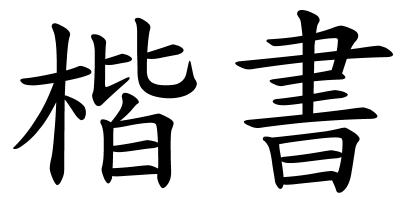Regular Script
|
|
Sheng_jiao_xu.jpg
The Regular Script, or in Chinese Kaishu (楷書 Pinyin: kǎishū) and Japanese Kaisho, also commonly known as Standard Regular (正楷), is the newest of the Chinese calligraphy style (peaked at the 7th century), hence most common in modern writings and publications (after the non-calligraphy printing Song Ti). It is also occasionally known as True Script (真書 Zhēnshū) and Standard Script (正書 Zhèngshū).
Regular Script came its current form in the 5th century during the Southern and Northern Dynasties. Script from this period is the "Wei Regular" (魏楷 Weikai). Some consider the Regular Script to be the direct derivative of Clerical Script, while others believe Running Script also has influence in some Regular Script calligraphers' styles as well.
The most famous Regular Script calligraphers of the Tang Dynasty whose style are imitated by latecomers include:
- The early Tang four great calligraphers (初唐四大家):
- Ouyang Xun (歐陽詢)
- Yu Shinan (虞世南)
- Chu Suiliang (褚遂良)
- Xue Ji (薛稷)
- "Yan-Liu" (“顏柳”)
- Yan Zhenqing (顏真卿)
- Liu Gongquan (柳公權)
Those Regular Script characters with width (or length) larger than 5 cm (2 in) is usually considered Larger Regular Script, or Dakai (大楷), and those smaller than 2 cm (0.8 in) usually Small Regular Script, or Xiaokai (小楷). Those in between are usually called Medium Regular Script, or Zhongkai (中楷). Or are compared in relation to those around.
Beginners often are recommended to start with the Eight Principles of Yong, which are said to contain the fundamentals of most, if not all, of the Regular Script calligraphy.
Notable artifacts with the Regular Scripts include:
- The Records of Yao Boduo Sculpturing (姚伯多造像記) during the Southern and Northern Dynasties
- The Tablet of Guangwu General (廣武將軍碑) during the Southern and Northern Dynasties
- The Tablet of Longzang Temple (龍藏寺碑) of the Sui Dynasty
- Tombstone-Record of Sui Xiaoci (蘇孝慈墓誌) of the Sui Dynasty
- Tombstone-Record of Beauty Tong (董美人墓誌) of the Sui Dynasty
Because of fearing the citizens using too many variant characters and Kanji characters, the Republic of China published in September 1982 the national standard of 4,708 commonly used Chinese characters, which are to be used in all elementary school textbooks. In addition, Government-sponsored television programs also appeared since then until late 1990s to instruct the public a word-a day the standard calligraphy.
The Zhuyin that annotates texts, although are not true Chinese characters, are virtually always written in the Regular Script style as well.
KaishuOuyangxun.jpg
Related pages
- Shodō (Japanese calligraphy)de:Regelschrift

